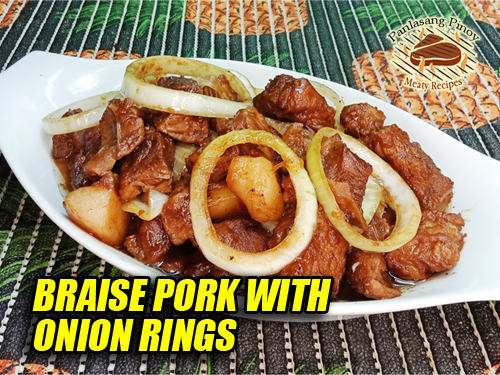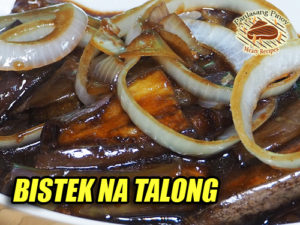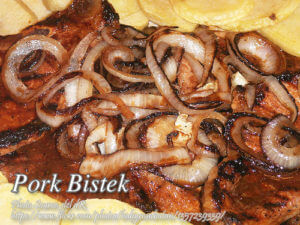This braised pork with onion rings dish is very easy to cook but you will not believe how tasty it is when it is already cooked and served. You might think this is pork bistek because of the onion rings, but if you will ask me, it is tastier then pork bistek. I think what makes this tastier is the method of cooking and the addition of cooking rice wine. With the extra step of braising the pork, the flavor is enhanced specially on meat dishes like this. And also the rice wine which help to enhance meat dishes which are mostly used in cooking Chinese dishes.
A Flavorful Filipino Comfort Dish
When it comes to Filipino cuisine, the concept of braising meat to achieve tender and flavorful results is a time-honored tradition. One dish that perfectly embodies this technique is braised pork, enhanced with the sweetness and tang of caramelized onions. This dish is a delightful combination of savory and slightly sweet flavors that is sure to become a household favorite.
A Peek into Filipino Braising Traditions
Braising is a cooking method that has long been used in Filipino households to tenderize tough cuts of meat while infusing them with rich flavors. This method involves cooking meat slowly in a seasoned liquid, allowing the flavors to meld and deepen over time. In the Philippines, dishes like adobo and mechado are classic examples of this technique, where meats are slowly simmered until they reach a succulent and flavorful finish.
The dish we’re focusing on today is another brilliant take on braised pork, made unique by the addition of caramelized onions. These onions lend a sweet and aromatic quality that balances the richness of the pork. This blend of flavors is a testament to the Filipino palate, which often seeks harmony between salty, sweet, and tangy tastes.
Preparing the Pork: A Seasoned Start
To begin preparing this dish, the first step is to ensure the pork is properly seasoned. Salt and pepper are the foundational seasonings here, providing a base layer of flavor. As you mix the pork with these simple ingredients, each piece becomes well-coated, setting the stage for a deliciously savory dish.
The importance of this initial seasoning step cannot be overstated. It’s what ensures that every bite of the meat is flavorful, even before it begins to soak up the rich sauces and aromatic ingredients that come later in the cooking process.
Sautéing: Building a Flavorful Base
Once your pork is seasoned, it’s time to build the base of the dish. The process begins with sautéing garlic and onions in hot oil until the onions soften and release their natural sweetness. This step is crucial as it forms the foundation of the dish’s flavor profile. The aroma of garlic and onions sizzling in the pan is a telltale sign that something delicious is on its way.
Next, the pork is added to the pan. As it sautés, it’s important to allow the meat to brown slightly. This browning process not only adds a depth of flavor through caramelization but also helps render the pork fat, which adds richness to the dish. The goal here is to cook the pork until most of its liquid evaporates, leaving behind the concentrated flavors of the meat and aromatics.
Enhancing the Flavor: The Magic of Sauces
The true depth of flavor in this dish comes from the careful addition of several key ingredients: rice wine, soy sauce, and oyster sauce. Each of these components plays a significant role in the final taste of the dish.
Rice wine adds a subtle acidity and a touch of sweetness, which helps to balance the rich flavors of the pork. Soy sauce, a staple in many Filipino dishes, brings a salty, umami quality that enhances the overall savoriness. Oyster sauce, with its thick consistency and sweet-salty profile, adds complexity and helps create a rich sauce that clings to the pork.
Once these ingredients are added, the sauce is allowed to reduce to half, intensifying the flavors and creating a glaze-like consistency that coats each piece of meat.
The Finishing Touch: A Sweet and Tangy Twist
To bring all the flavors together, brown sugar and calamansi juice are added next. The sugar provides a hint of sweetness that contrasts beautifully with the savory elements, while the calamansi juice adds a burst of citrusy brightness, cutting through the richness of the dish.
After stirring these ingredients in, boiling water is poured into the pan to create a simmering environment that allows the pork to cook slowly and evenly. This final cooking step, where the dish is covered and left to simmer for an hour, is where the magic happens. The pork becomes tender and absorbs all the complex flavors of the sauce.
The Onions: A Sweet Finish
As a final touch, white onion rings are added to the dish just before serving. These onions provide a fresh, sweet, and slightly crunchy contrast to the tender pork, adding another layer of flavor and texture. After a brief simmer, the dish is ready to be served.
Serving Suggestions and Final Thoughts
Braised pork with onions is best enjoyed with a steaming bowl of white rice, which soaks up the rich sauce and balances the flavors. This dish, with its tender meat and savory-sweet sauce, is a comforting meal that embodies the warmth of Filipino home cooking.
For those new to Filipino cuisine, this dish offers a glimpse into the rich culinary traditions that have been passed down through generations. The technique of braising, combined with the careful balance of flavors, makes it a dish that’s both satisfying to eat and rewarding to cook. Whether you’re a beginner or an experienced cook, this recipe is a wonderful addition to any home-cooked meal.
How to Cook Braised Pork with Onion Rings
Ingredients
- 1 kilo pork shoulder or pork butt kasim, slice into large chunks
- 5 cloves garlic minced
- 2 pcs red onions chopped
- 2 Tbsp. soy sauce
- 1 Tbsp. oyster sauce
- 1/2 tsp. black peppercorns ground
- 1/2 tsp salt
- 1 Tbsp. brown sugar
- 1 Tbsp. fresh calamansi juice
- 2 Tbsp. cooking rice wine optional
- 1 liter boiling water
- 2 pcs white onions sliced into rings
- 3 Tbsp. cooking oil
Instructions
How to Cook Braised Pork with Onion Rings:
- Put the pork in a bowl and season with salt and pepper. Then mix the pork until well coated with the seasoning.
- Heat oil in a pan and saute garlic and onions until onions are soft. Then add in the pork and stir.
- Saute the pork until slightly brown and the liquid has evaporated and also the fat renders.
- Pour cooking rice wine and stir. Then add soy sauce and oyster sauce. Stir until the sauce is reduced to half.
- Then add in brown sugar and calamansi juice. Stir for a minute then pour boiling water in the pan.
- Cover and simmer until for and hour or until the pork is tender. Then add in the white onion rings and stir. Simmer for a minute then turn off heat. Serve and enjoy!
Video
Notes
Cooking Tips:
Achieve Perfect Browning for Deeper Flavor
To get the best flavor out of your pork, make sure to brown it evenly before adding the sauces. Browning helps to caramelize the surface of the meat, locking in moisture and creating a richer taste. Avoid overcrowding the pan to ensure each piece browns properly.Use Fresh Calamansi Juice for a Bright Finish
For the most authentic flavor, always use freshly squeezed calamansi juice instead of bottled alternatives. The fresh juice offers a more vibrant and tangy taste, enhancing the overall balance of the dish. If calamansi isn’t available, a mix of lemon and lime juice can be a good substitute.Simmer Low and Slow for Tender Meat
Patience is key to achieving melt-in-your-mouth pork. Keep the heat low and allow the meat to simmer slowly in the sauce, absorbing all the delicious flavors. This slow cooking process ensures the pork becomes tender and juicy, making it the perfect comfort food.





